The Parish of Llanegwad sits around the A40 from Carmarthen to Llandeilo. The village comprises a cluster of houses and surrounding Farms. Inside the Church are two War Memorials. The War Memorial to the fallen of the Great War is made of marble, and is mounted on the interior wall of the church, as is a private memorial to Lieutenant G. A. Griffiths. The Memorial to the men of World War Two is sited at the Memorial Hall at nearby Cothi Bridge. Many thanks to the Reverend Philip Johnes for the photographs of the WW1 memorial and of the memorial to Lieutenant GA Griffiths.
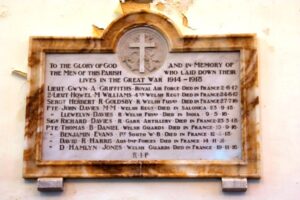
The Great War, 1914-1918
Thomas Benjamin Daniel, Guardsman, 1933, Welsh Guards. Thomas was the son of Herbert and Elizabeth Daniel, of the Post Office, Nantgaredig. He worked as a Draper’s Assistant at Carmarthen prior to the war. In February 1915 he enlisted into the 1st Battalion of the newly formed Welsh Guards. The Welsh Guards sailed for France in July 1915, joining the 3rd Guards Brigade, Guards Division. The Welsh Guards saw their first action during the Battle of Loos in September 1915, then spent the winter at Ypres before moving back to the Somme in the summer of 1916. The Guard then took part in the Battle of Flers-Courcelette, which was a part of the main Somme offensive. Thomas was killed in action here on 10 September 1916, aged 22. He is buried in Delville Wood Cemetery, Longueval, France. His brother D. J. Daniel, of Nantgaredig, survived him.
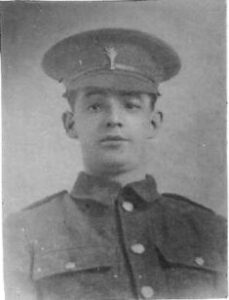
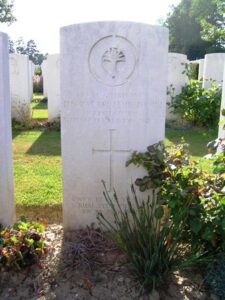
Johnny Davies, MM, Private, 14895, Welsh Regiment. Johnny was the son of William and Jane Davies, of Pantglas, Cothi Bridge. He enlisted at Cardiff into the 11th Battalion (Cardiff Pals), which was attached to 67 Brigade, 22nd Division. The division initially moved to the Western Front, but after a brief period there was sent to Salonika. It then took part in several battles against the Bulgarians. It was during the Salonika Campaign, at the Battle of Doiran, that Johnny was mortally wounded. He died of his wounds on 25 September 1918, aged 26. Johnny is buried at Sarigol Military Cemetery, Kriston. He had won the Military Medal, for Bravery in the Field.
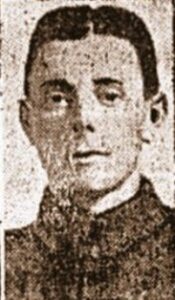
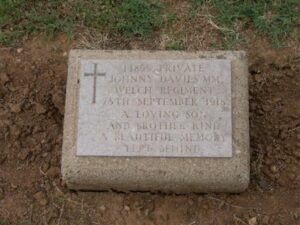
Llewellyn Davies, Private, 12225, Royal Welsh Fusiliers. Llewellyn was the son of Henry and Anne Davies, of Llether Cottage, Llanegwad. He enlisted at Ammanford into the 8th Battalion, Royal Welsh Fusiliers. The Battalion was attached to the 40th Brigade, 13th (Western) Division, and on 13 June 1915 sailed to Alexandria. During July the division landed on Cape Helles and relieved the 29th Division. The following month saw the division move to ANZAC Cove, taking part in the Battles of Sari Bair, Russell’s Top, and Hill 60, ANZAC. Soon afterwards the Division was transferred from ANZAC to Suvla Bay, and it was evacuated from Suvla on 19 December 1915. On 8 January 1916, the Division was evacuated from Helles, and concentrated at Port Said, where they held forward posts in the Suez Canal defences. On 12 February 1916 the Division began to move to Mesopotamia, to strengthen the force being assembled for the relief of the besieged garrison at Kut al Amara, assembling near Sheikh Saad under orders of the Tigris Corps. The force then took part in the attempts to relieve Kut. However, after these efforts failed and Kut fell, the British force in the theatre was built up and reorganised. Llewellyn was taken ill during the expedition into Iraq, and died there on 19 May 1916, aged 23. He is buried at the now devastated Basra War Cemetery, Iraq. His brother Richard also fell.
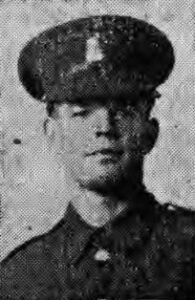
Richard Davies, Gunner, 77856, Royal Garrison Artillery. Richard was the son of Henry and Anne Davies, of Llether Cottage, Llanegwad. The family later resided at Glynaber, Twyn, Garnant. He enlisted at Ammanford on 8 May 1916 into the Royal Artillery, and was posted to the RGA Depot in France on 4 August 1917. From here, Richard was posted as a reinforcement to the 76th Siege Battery, Royal Garrison Artillery. The battery was in the St. Quentin sector early in 1918, and was hit by the German Spring Offensive, which was launched there on 21 March 1918. After two days heavy fighting, Richard was mortally wounded, and died on 23 March 1918 at the 1/3rd Highland Field Ambulance. Richard was 24 years old. He was buried at Villers Brettoneux Military Cemetery, Fouilloy, France. His brother Llewellyn also fell.
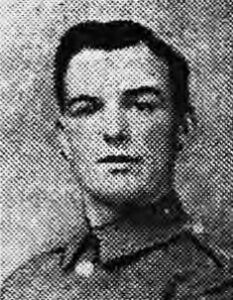
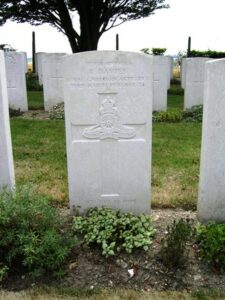
Benjamin Evans, Private, 13461, South Wales Borderers. Benjamin was the son of Benjamin and Bridget Evans, of Tynewydd, Nantgaredig. Benjamin enlisted at Newport Gwent, into the 1st Battalion, South Wales Borderers, which was attached to 3 Brigade, 1st Division. The division had fought in France since the beginning of the Great War, and in early 1918 was in Flanders. On 21 March 1918, the Germans launched Operation Michael, known as the Kaiserschlacht. This was their last chance to win the war before the growing American Expeditionary Force could be lined up against them. In early April 1918, the 1st SWB were helping in a desperate defence of the Allied lines, when Benjamin was wounded. He was taken to the Military Hospital at Etaples, where he succumbed to his wounds on 13 April 1918, aged 24. Benjamin is buried in Étaples Military Cemetery, France.
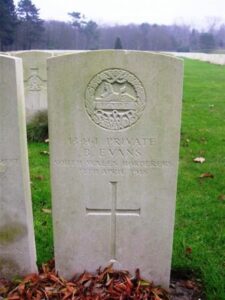
Herbert Roye Goldsby, MM, Sergeant, 12854, Royal Welsh Fusiliers. Herbert was born on 16 August 1886, the son of Edwin and Elizabeth Goldsby, of Paddington, London. He had moved to West Wales by 1911, working as a coal hauler at Llandebie, before moving to Llanedi. He enlisted at Tumble into the 9th Battalion, Royal Welsh Fusiliers, who were attached to 58 Brigade, 19th (Western) Division. The Division assembled around Bulford during September 1914. Divisional training was completed near Tidworth, from March 1915, and the Division crossed to France between 11 and 21 July 1915, and moved to positions near Loos. The Division fought during the opening attack of the Battle of Loos, and then moved to the Somme, where they took part in the second wave of the attack on Ovillers-La Boiselle on the 1st July, capturing the village at heavy cost, and fought through the Somme Battle of Pozieres, where Herbert was killed in action on 27 July 1916. He was 28 years old, and is remembered on the Thiepval Memorial, France. Herbert had won the Military Medal for Bravery, and as it was a relatively new award at that time, it must have been for the attack on Ovillers.
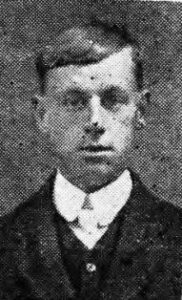
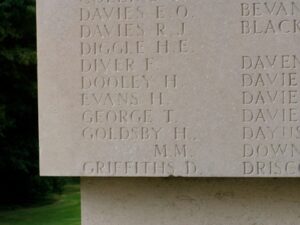
Gwyn Arthur Griffiths, Lieutenant, Royal Air Force. Gwyn was born in 1893, the son of John and Elizabeth Jane Griffiths of Ty Pica, Golden Grove, Carmarthenshire. He was commissioned Second Lieutenant into the 15th Welsh (Carmarthen Pals) on 31 March 1915 and embarked with the battalion to France on 4 December 1915. In the summer of 1916 Gwyn transferred to the Royal Flying Corps, where he trained as an Observer, and was posted to 35 Squadron, RFC. On 2 June 1917 Gwyn, along with his Pilot Lieutenant E. R. Bottomley, where flying an artillery observation mission over Vermand in their Armstrong Whitworth FK8, Serial A2718, when they were hit by Anti Aircraft fire and forced down behind German lines. Both men were taken prisoner, but Gwyn had been badly wounded, dying that same day. He was 24 years old and is buried at Mons en Chaussée Communal Cemetery, France.
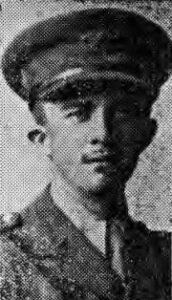
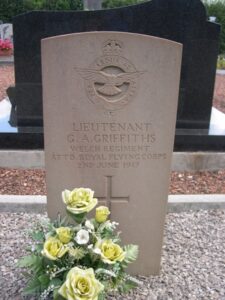
David Rixon Harries, Private, 4715, Australian Infantry. David was born on 2 February 1891, the son of John and Jane Harris, of Blaenantymab Farm, Nantgaredig. David had emigrated to Australia in 1911, prior to the Great War, and found work as a Stockman at Rockhampton in Queensland. David had enlisted there at Rockhampton on 6 December 1915 into the Australian Imperial Force, and embarked from Sydney on 12 April, 1916 aboard the HMAT Mooltan, bound for England, as part of the 15th Reinforcements for the 25th Battalion. In England, the Australians trained at Salisbury Plain, and were then sent to the Western Front. David proceeded to France on 9 September 1916, and joined his unit, the 25th Battalion. The Battalion was attached to the 7th Brigade, 2nd Australian Division, and by that time had suffered terrible casualties on the Somme, during the fighting at Pozieres and Mouquet Farm. By now the fighting had pushed further along the old Roman Road from Albert to Bapaume, and the Australians were in the Warlencourt area. On the morning of 14 November 1916 the Battalion was at Turk Alley Trench near Flers, and attacked the German lines opposite them. David was posted missing, but a subsequent investigation and court of enquiry found that he had actually been killed in action during the attack that day. David was 24 years old, and after his body had been recovered, some three months later during the German withdrawal on the Somme, he was buried at Warlencourt British Cemetery, France.
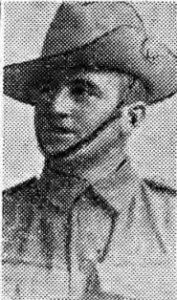
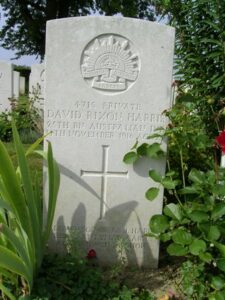
Caleb Sidney Jones, Private, 292718, Royal Welsh Fusiliers. Caleb was the son of John and Dinah Jones, of Llanegwad. He had served with the 1st Volunteer Battalion, Welsh Regiment prior to moving to 59, Court Street, Tonypandy prior to 1911, and worked there as a tailor. Caleb enlisted there on 14 January 1915 into the Army Service Corps. He was mobilised on 22 August 1916 and posted to the Royal Welsh Fusiliers, and in May 1917 sailed for Egypt, where he joined the 24th Battalion (Denbigh Yeomanry), Royal Welsh Fusiliers. The battalion had been formed in Palestine after the disbanding of the Yeomanry Battalions in 1917, and was attached to 231 Brigade, 74th (Yeomanry) Division. The Division had formed in Egypt in January 1917 and fought through the Palestinian Campaign, at the Battles of Gaza and the Battle and capture of Jerusalem. Caleb was killed in action after the capture of Jerusalem, during the Battle of Jaffa, on 27 December 1917. He was 36 years old, and is buried at Jerusalem War Cemetery, Israel. Caleb is not commemorated locally.

David Hamlyn Jones, Private, 435, Welsh Guards. David was the son of Dr. Evan and Margaretta Jones, of Cothi Hall, Llanegwad. He had served with the 2nd Battalion, Welsh Regiment for several years prior to the war before transferring to the Grenadier Guards. On 26 February 1915 a Royal Warrant was raised, which gave the go ahead for the formation of the Welsh Guards. Many serving Guardsmen who originated from Wales transferred to this new Guards Battalion, and David was one of them. He moved to the 1st Battalion, Welsh Guards, which was attached to the 3rd Brigade, Guards Division. The Division remained on the Western Front throughout the war and saw its first major action during the Battle of Loos on 25 September 1915, remaining in the area during the coming months, where they also fought in the subsequent Action of Hohenzollern Redoubt. In July 1916 the Division moved to the Somme, where they fought at the Battle of Flers-Courcelette, and then at the Battle of Morval, capturing Lesboeufs Village. They remained here for the winter, and it was here on 19 November 1916 that David was killed. He was 27 years old, and is remembered on the Thiepval Memorial, France.
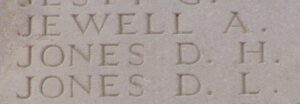
John Lewis Jones, Second Lieutenant, Welsh Regiment. John was the son of Dr. William Lewis Jones and Mrs. Elizabeth Jones, of Glyncothi, Nantgaredig. He was orphaned at an early age, and brought up by family at Caio. Prior to the war John lived with his cousin, Mrs. Walters and Miss Davies, at Walters Hotel, Lampeter. He had been commissioned into the Welsh Regiment, and had joined the 3rd Battalion for his training. John was sent to France in 1916, and fought there for seven months with one of the Service Battalions of the Welsh Regiment, until he was gassed, and sent home for treatment. John’s condition worsened and he died at Bedford House Hospital, Cardiff on 13 August 1917, aged 32. John is buried at Llanegwad (St. Egwad) Churchyard, North of the Church tower. He is not commemorated on the Llanegwad War Memorial, but at Caio, Pumsaint and Lampeter, as well as at Builth Wells.
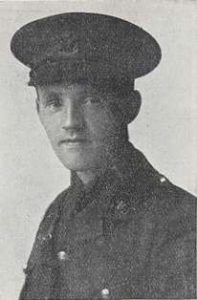
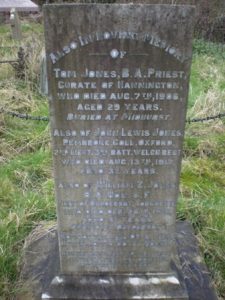
Howel Morgan Williams, Second Lieutenant, Welsh Regiment. Howel was the son of John and Catherine Williams, of Gwynondale, Llanarthney, and was commissioned into the Welsh Regiment, serving with the 19th Battalion, which was the Pioneer Battalion to the 38th (Welsh) Division. The Division had landed in France during December 1915 and had spent their first winter in the trenches near Armentieres. In June they marched south to the Somme, where they were tasked with the capture of Mametz Wood. The attack on the wood began on 7 July, but met with fierce resistance, and it took until 14 July to clear the wood. The Division suffered terrible casualties at Mametz, and were taken out of the line, and moved to Ypres to rebuild. Howell was killed in action during the build up to the Third Battle of Ypres, on 24 June 1917, when a shell crashed into his dugout, killing him and Captain Arthur Ernest Evans, of Swansea, and wounding Lieutenant Bert Palmer and another man. Howell was 23 years old, and is buried at Bard Cottage Cemetery, Belgium. He is also commemorated on the Llanegwad Memorial. (The County Roll shows his brother Chaplain Philip Williams, but he lived for many years after the war).
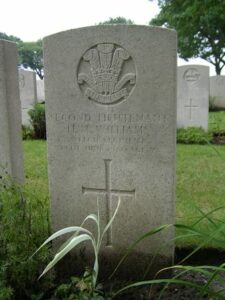
Ronald Wray, Private, 547412, Labour Corps. Ronald was born at Bramley, Leeds, the son of Alfred and Ada Wray. He resided at Llanegwad prior to the war, but returned to Leeds to enlist into the West Riding Regiment. He later transferred, probably after being passed as unfit for front-line service, into the 864th Agricultural Company, Labour Corps. Ronald died of sickness on 2 November 1918, aged just 19, and is buried at Leeds (Harehills) Cemetery. Ronald is not commemorated locally.
——————————————————————————————————————————————–
World War Two, 1939-1945
A ceremony was held at the Memorial Hall, Cothi Bridge on Thursday, 13 May 1948 unveiling the tablet in memory of the men of the district who fell 1939-45 and others who served their country. Thanks to Gwenda Lanagan for the list of names.
David Harold Harries, Sergeant, 1377756, Royal Air Force Volunteer Reserve. David was the son of Thomas and Annie Maria Harries of Penllwynau, Abergwili. He left home to work in a Drapery in Bromley prior to the war and lodged at 23, Palace Road, Bromley. David enlisted into the Royal Air Force Volunteer Reserve and after completing his training as a Wireless Operator/ Air Gunner was posted to 487 (RNZAF) Squadron, Royal Air Force, which was a New Zealand staffed squadron, equipped with the Lockheed Ventura II, based at RAF Feltwell. He married Joyce Lilian Worley, of Southwark, whilst on leave in Blackpool in the summer of 1941. On the night of 6 December 1942, David took off from Feltwell aboard a Lockheed Ventura II, Serial AE902, as part of Operation Oyster, a raid on the Philips radio and valve factory at Eindhoven. Some 93 bombers left Britain to attack the factory, which was extensively damaged, but there were 17 aircraft lost. Among those was the Ventura which David was a crewman in, which was hit by flak at low level and crashed, killing David and three other crewmen. David was 31 years old, and is buried in Eindhoven (Woensel) General Cemetery, Netherlands.
David John Jones, Private, 7672679, Royal Army Pay Corps. David was born on 28 September 1919, the son of David Jones and Selina Jones (nee Morris), of Myrtle House, Nantgaredig. He was educated at Carmarthen Grammar School before gaining a role as a local government clerk. David enlisted into the army at some time after the outbreak of war and was posted to the Royal Army Pay Corps. Very little else is presently known about him, but he was killed in an accident on 26 September 1944. The remains of the 24-year-old were brought home and he was buried in Siloam Congregational Chapelyard, at Cothi Bridge.
William Samuel Northwood, Leading Aircraftman, 948273, Royal Air Force Volunteer Reserve. William was born on 1 July 1912, the son of Walter Northwood and Jane Northwood (nee Davies), of Court Henry Mill, Llangathen. His father died in 1920, so his mother moved with her young family to Llwynarel, Llanegwad. William, who worked as a motor mechanic, married Eileen Nicholas, a nurse at Pantglas Hall, in the autumn of 1940. He enlisted into the Royal Air Force Volunteer Reserve and was posted to 84 Squadron, Royal Air Force. The Squadron left Heliopolis by air and sea parties between January 14th and 18th 1942, bound for the Far East, to help counter the Japanese. The first flight of the Air Party was inspected by Air Marshall Sir Arthur Tedder, ACC in Chief Middle East, on the afternoon of 13 January, and the squadron moved by way of Habbaniya, Bahrein Island, Sharjah, Karachi, Allahabad, Calcutta, Toungoo, Rangoon, Lhoknga, and Medan to Palembang. The sea party left Heliopolis at 21.00 hours on 16 January, and had reached Oosthaven, Sumatra, on 14 February 1942, tragically the same day that the Japanese parachute troops invaded Palembang aerodrome. The first five aircraft of the Squadron arrived at Palembang in the afternoon to find that the aerodrome had been bombed and ground-strafed at 09.00 hours that morning. The air-crews were given instructions to leave at 07.45 next morning for P2, 45 miles South West of Palembang, which was the Squadron’s base for the remainder of the time it was in Sumatra. By the middle of February, it was clear that Sumatra would soon be over-run, and on the 14th Japanese parachutists landed, and evacuation was ordered. William was one of the hundreds of RAF men captured by the Japanese, and he is believed to have been shot By Japanese Troops at Tjilatjap, Java on 9 March 1942. The 29-year-old has no known grave, and is commemorated on the Singapore Memorial, Kranji.
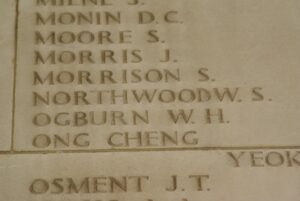
William Howard Preece, Ordinary Seaman, Merchant Navy. William was born in 1925, the son of Christopher Preece and Elsie May Preece (nee Norris), of The Knoll, Llanegwad. He left home to join the Merchant Navy as a young man, and joined the crew of the steamship SS Pendeen, which was registered at Falmouth and under the command of Captain John Jones, of Llandyssul. William fell overboard and drowned in the Three Rivers, Canada on 11 August 1940, aged only 15. Nothing further is known of him, as he is not commemorated as a war casualty by the CWGC.
John Henry Stafford, Private, 13062800, Pioneer Corps. John was born on 27 November 1918, the son of Henry George Stafford and Margaret Stafford (nee Jones), of Bradford on Avon, Wiltshire. His parents moved to Whitchurch, Cardiff soon after his birth. Prior to the war John resided at Cincoed, Cothi Bridge, where he worked as a farm labourer. He enlisted into the army and was posted to the Pioneer Corps. John was then attached to a unit in Liverpool. At 22.00 on 2 May 1941, air raid sirens sounded across the city, then just before midnight the city was targeted by hundreds of Luftwaffe bombers. John was killed together with a number of his comrades that night, on 2 May 1941. The remains of the 22-year-old were recovered and he was brought home for burial in Cathays Cemetery, Cardiff.
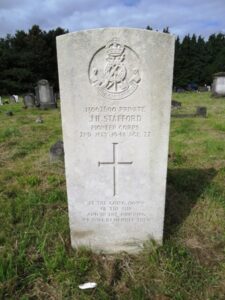
John Douglas Walters, Gunner, 920412, Royal Horse Artillery. John was born in 1916, the son of Thomas Walters and Annie Mary Walters, of Gwynfryn, Nantgaredig. He enlisted into the army and was posted to the 4th Regiment, Royal Horse Artillery. The Regiment was formed at Helmieh in Egypt in May 1939 from three batteries drawn from independent commands in India, and fired the opening rounds of the campaign in North Africa on the 8th December, 1940 against the Italians at Sidi Barrani. As part of 7th Armoured Division, the Regiment was involved in numerous subsequent battles in the desert, including Bardia, the capture of Tobruk, Beda Fomm, Sidi Rezegh and the withdrawal from Gazala to El Alamein. It then took part in the Battle of El Alamein as part of 1st Armoured Division, later taking part in the battle for the Mareth Line and the capture of Tunisia. John was badly wounded in Tunisia on 30 May 1942 and died of his wounds that same day. The 26-year-old was originally buried in the desert in Cyrenaica, but in June 1944 the isolated graves in the area were exhumed and re-interred in Knightsbridge War Cemetery, Acroma.
David Hywel Thomas Williams, Donkeyman, Merchant Navy. David was born on 6 April 1914, the son of Sylvanus Williams and Mary Ann Williams (nee Thomas), of Ty’ryscawen Farm, Carmarthen. He was baptised at St. Peter’s Church on 24 May 1914. David resided at The Grove, Llanegwad prior to the war, then enlisted into the Merchant Navy and was posted aboard the Liverpool registered oil tanker, MV Cordelia. On 3 February 1943 Cordelia was on route from Curacao for New York and the Clyde carrying 12,000 tons of Admiralty Fuel Oil, when she was torpedoed and sunk by the German submarine U-632. David was 28 years old when he died that day, and is commemorated on the Tower Hill Memorial, London. Probate was granted to his sister, Nancy Felix, at 17, Mansell Street, Carmarthen. David does not seem to be commemorated locally.

John Purvis Williams, Captain, LC/6534, 10th Gurkha Rifles. John was born in 1922, the son of the Reverend Gomer Oscar Williams, M.A., and Jennie Williams (nee Jones), of Wilton Vicarage, Redcar, Yorkshire. His uncle, John Lewis Jones, of Llanegwad, died during the Great War. John was commissioned into the Indian Army, and served with the 2nd Battalion, 10th Gurkha Rifles. The battalion had taken part in the Middle Eastern campaign, before joining the invasion of Italy. John was killed in action during the Italian Campaign, on 13 September 1944. The 22-year-old was buried in Coriano Ridge War Cemetery, Italy. John is commemorated on his grandfather, Reverend Tom Jones, grave at Llanegwad but, as far as is known, is not commemorated on any war memorial locally.